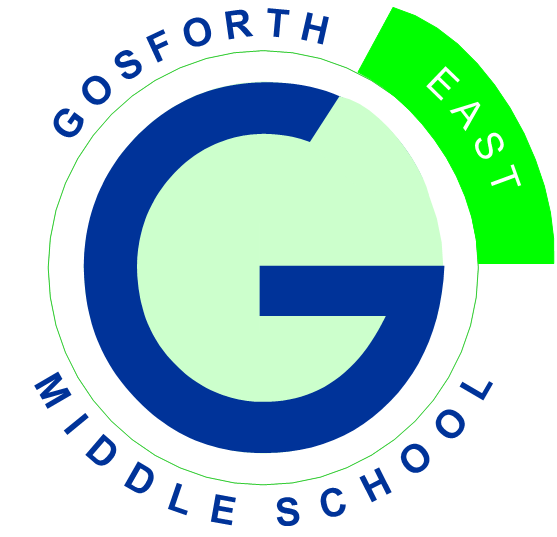Computing

Computing at GEMS
Curriculum Intent
At Gosforth East Middle School, we see ourselves as being in the pursuit of excellence and want our pupils to be prepared to succeed the world of further study and work. Technology is everywhere and will play a pivotal part in our students' futures. We see 4 key areas for personal development which we think apply squarely with the kinds of transferrable skills required for excellence in education and in employment:
1 – Resourcefulness – the confidence to solve problems – a key skill required for those that write code or produce digital solutions.
2 – Relationships – the confidence to work in teams of varying size – the standard way of working in the IT industry.
3 – Reflection – the confidence to move forward and improve – important for progressing any learning and career.
4 – Resilience – the will to overcome challenges and see challenging tasks through to their completion.
To improve in Computing, pupils need a broad and balanced curriculum which includes the three main elements of Computer Science:
1 - Computer Science (The knowledge of how computers work):
-
Knowledge of computation and how computers work - algorithms and programming to solve problems
-
knowledge of data including the different ways data can enter a computer system, how it is processed and how it is output
-
an understanding of systems i.e. how different component parts of a device work, how devices work together and also how they might work when linked together e.g. the internet.
2 – Information Technology – (The knowledge of how computers can be used):
-
Digital artefacts – knowledge of how to create them
-
Computing contexts – how computing is used in various ways and what technology legalities and ethics underpin those uses.
3 - Digital Literacy – (The knowledge of how to use technology in an effective, responsible and safe way):
-
Mechanics - how to use devices
-
Searching for and selecting information
-
E safety
Our curriculum is developed from the Teach Computing Curriculum, written by experts from the National Centre for Computing Education with progression and understanding of these three main strands in mind. Being a current and contemporary framework, it demonstrates the breadth and depth of the computing curriculum and exemplifies how Computing teaching can be taught well, based on research. It also highlights areas for subject knowledge and pedagogy enhancement for teachers through training, something that we intend to take advantage of as we continue to develop our expertise.
Information Technology brings many advantages for students by allowing them to share their learning in creative ways and provides accessibility opportunities to scaffold learning.
At GEMS we seek to reinforce the message of there being a choice in the content we upload or publish and therefore we look to model ways for pupils to be able to use technology positively, responsibly and safely. We recognise that the best prevention for a lot of issues we currently see with technology/social media is through education via the Project Evolve e-safety curriculum (this meets all the requirements of the Education for a Connected World framework which demonstrates the knowledge and understanding required for internet safety across the age ranges).
How students are supported in Computing
Gosforth East Middle School is an inclusive school where every child is valued and respected. We strive for excellence and are committed to the inclusion, progress and resilience of all of our students, including those with SEN. We support our students to make progress in the 3 key areas of Computer Science, ICT and Digital Literacy. Finding the right balance with technology is key to an effective education and a healthy life-style. We feel the way we implement Computing helps children realise the need for the right balance and one they can continue to build on in their next stage of education and beyond.
Our Teach Computing Curriculum is inclusive and ambitious: this means that it has been written to support all pupils. We strive to continuously adapt it to suit the needs of our learners. Alongside this, the head of department has produced a comprehensive progression document (which is tied in closely to the curriculum, for if the curriculum is being learned then progress is being made by our students) for staff to follow: this includes knowledge and skills statements that build year on year to deepen and challenge our learners.
Each lesson is sequenced so that it builds on the learning from the previous lesson and, where appropriate, activities are scaffolded so that all pupils can succeed and thrive. Scaffolded activities provide pupils with extra resources, such as visual prompts, to reach the same learning goals as the rest of the class. We are mindful of choosing the right activities to meet these learning goals and not choosing activities merely because they will be exciting. Exploratory tasks foster a deeper understanding of a concept, encouraging pupils to apply their learning in different contexts and make connections with other learning experiences.
As well as scaffolded activities, embedded within the lessons are a range of pedagogical strategies backed by recent research, which promote making the Computing topics more accessible:
-
Lead with concepts – Glossaries, concept maps, displays along with regular recall and revision to support pupils in the acquisition of knowledge, through the use of key concepts, terms, and vocabulary,
-
Structure lessons – Within lessons supportive frameworks which are based on research and allow for support and challenge to be built in to lessons such as PRIMM (Predict, Run, Investigate, Modify, Make) and Use-Modify-Create
-
Make concrete – We use real world contextual examples and focus on links with other curriculum subjects in order to bring abstract concepts to life. This happens when we use unplugged activities, propose analogies, storytell around a concept and find examples of the concepts in our pupils’ lives.
-
Unplug, unpack, repack via semantic waves – We teach new concepts by first unpacking complex terms and ideas, exploring them in familiar and maybe unplugged contexts, then repacking the new understanding back into the original context.
-
Work together – taking the lead from the IT industry, we encourage collaboration, specifically using pair programming and peer instruction, and also structured group tasks. Working together stimulates classroom dialogue, articulation of concepts, and development of shared understanding.
-
Read and explore code first – When we teach programming, we first focus on “code reading activities” before we engage in code writing. With block – based and text-based programming, we encourage pupils to review and interpret blocks of code. This is backed by research that shows that being able to read, trace and explain code augments pupils’ ability to move towards writing code, very much like furthering someone’s reading skills will further there writing skills in English.
-
Create projects – We use project based activities to provide pupils with the opportunity to apply and consolidate their knowledge and understanding. Design is an important, often overlooked aspect of computing. Pupils can consider how to develop an artefact for a particular user or function, and evaluate it against a set of criteria.
-
Model everything – we model processes and practices – everything from debugging code to binary number conversions, using techniques such as worked examples and live coding. Modelling is particularly beneficial to novices, providing scaffolding that can be gradually taken away.
-
Get hands on – The curriculum allows us to use physical computing and making activities that offer tactile and sensory experiences to enhance learning, combining electronics and programming with arts and crafts (especially through exploratory projects) to provide the pupils with a creative engaging context to explore and apply computing concepts.
-
Challenge misconceptions – Formative questioning allows us to uncover misconceptions and adapt our teaching to address them as they occur. We aim to promote awareness of common misconceptions alongside discussion: concept mapping, peer instruction or even simple quizzes can help identify areas of confusion.
-
Add variety – We like to tailor the activities we provide to include different levels of direction, scaffolding and support that promote active learning, ranging from the highly structured to more exploratory tasks. We also aim to adapt our instruction to suit different objectives to help keep all pupils engaged and encourage greater independence.
-
Foster program comprehension – we use a variety of activities to consolidate knowledge and understanding of the function and structure of programs, including debugging, tracing, and Parson’s Problems. Regular comprehension activities help secure understanding and build connections with new knowledge.
Assessment
In Computing at GEMS, we use a range of assessment strategies to promote and measure learning, always staying mindful of the fact that assessment merely samples what has been learned, staying focused on the need to cover complete breadth of our curriculum and looking to shape subsequent lessons to meet the needs of our pupils.
All Teach Computing lessons include formative assessment opportunities which are used and adapted by our team with the aim of revealing misconceptions and allowing them to be addressed if and when they occur. These activities can vary from teacher observation or questioning to marked activities.
In many lessons, short 2/3 question multiple choice questions (MCQs) are presented as a quick, low stakes way for the children to receive automated feedback on the questions they answer and an another way of uncovering misconceptions to supplement targeted and carefully planned questioning throughout the lesson.
An annual multiple choice question assessment using the Computing at School materials on the Diagnostic Questions platform also allows our team to analyse areas of strength and areas for development for the pupils, thus allowing them further scope to shape the lessons accordingly, responding to what is already known and with the aim of avoiding overloading of working memory.
Enrichment Opportunities
Code Club is held once a week allowing children to explore Coding in more depth and in the direction of their interests.
Visits to the Apple store in Newcastle upon Tyne
Visits to the Escape Key in Newcastle Upon Tyne
Visits to exhibitions at local venues e.g. Game on 2.0 at the Centre for Life.
Code.org is periodically set as homework.
Useful Links
E-Safety
https://www.nspcc.org.uk/keeping-children-safe/online-safety/
https://www.ncsc.gov.uk/cyberaware/home
https://www.security.org/how-secure-is-my-password/
https://www.ditchthelabel.org/
https://wordpress.org/openverse
Curriculum
https://makecode.microbit.org/
https://www.bbc.co.uk/bitesize/subjects/zvnrq6f
https://arcade.makecode.com/
Topic Overview
|
Year 5 |
Introduction to schools network, Word Processing, Graphic Modelling, Internet safety, internet safety, ipad movie, logo control, spreadsheets, pivot and Computer Science. |
|---|---|
|
Year 6 |
Word processing, Publisher, spreadsheets, powerpoint, internet safety, Computer Science logo, Flowal, Animation, Pivot, Databases. |
|
Year 7 |
Microsoft software, E safety, Dance ejay, database, web design, Pivot, Binary and control, logo, Animation. |
|
Year 8 |
Microsoft Skills, Web Code, Scratch, Multimedia, Flash, Mission maker, Spreadsheet |
Resources to support your child’s learning
Any programming Apps on Android or Ipads eg A.L.E.X and Hopscotch
Parent friendly homework
All pupils have access to www.iamlearning.co.uk, Typing skills.
